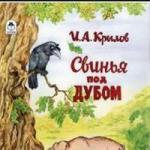From the pen of the great master Ivan Andreevich Krylov came a huge number of unsurpassed and instructive stories. He considered the purpose of his ridicule of human vices to be the purification of the world. His works are relevant in our modern times.
The fable “The Pig under the Oak,” unlike the others, has no prototype. This plot is not found in other fabulists. Krylov in this sense is completely original.
Once again, animals are traditionally used as characters. True, there are also plants in this work. Moreover, some and others with bright characteristics. The pig is a symbol of dirt and stupidity, the Raven is a wise bird, but the oak is a majestic and powerful tree. Using the example of animals, it is probably easier to show all the shortcomings of man. This is what Krylov plays on.
The images of the main characters in the fable are clearly designed for people. The Pig is a lazy person who does not value the work and achievements of others. Limited in mind, she is so proud that she does not notice anyone or anything around her. Raven is a person with a wealth of experience, who easily notices the mistakes of others and has the right to point them out. Oak is a kind and calm person, simply and without pretension giving others the right to enjoy his benefits.
It is not possible to decide which of these heroes is more important. One can only assume that this is an oak tree, since it is this that explains the essence of the morality of the work.
As for the moralizing result, it can be viewed in two ways: broadly, this is, of course, a condemnation of an ungrateful and ignorant attitude. But narrowly: the attitude of illiterate people to scientific achievements. People who are far from understanding the significance of inventions must be kept at a distance from them. In their hands they will only be spoiled. Pigs, having received everything they need and satisfied their base needs, can only humiliate the authority of those involved in the scientific discovery, smart and educated people.
The composition of the fable consists of two parts. This division is quite traditional for Krylov. The first part is a narration of the whole story, the second is a final quatrain with a lesson. As for the rhythmic structure of the work, Krylov makes extensive use of inversion. This results in a more comfortable experience.
Ivan Andreevich in his fable “The Pig under the Oak” touched upon important and serious problems, but at the same time conveyed it so easily and simply that it is understandable and accessible even to children.
Pig under the oak tree drawing
Pig under the ancient oak
I ate my fill of acorns to satiety;
Having eaten, I slept under it;
Then, having cleared her eyes, she stood up
And she began to undermine the roots of the Oak tree with her snout.
“After all, this harms the tree,”
Raven tells her from Dubu, -
If you expose the roots, it may dry out."
“Let it dry,” says the Pig, “
It doesn't bother me at all,
I see little use in it;
Even if he were gone forever, I wouldn’t regret it at all;
If only there were acorns: they make me fat.”
“Ungrateful!” Oak said to her here, “
Whenever you could lift your snout up,
You should have seen
Why are these acorns growing on me?
The ignoramus is also blinded
Scolds science and learning
And all the scientific works,
Without feeling that he is eating their fruits
Moral of the story
The ignoramus is also blinded
Scolds science and learning
And all the scientific works,
Without feeling that he is tasting their fruits.
Moral in your own words, the main idea and meaning of the fable The Pig under the Oak
Only the ignorant scold science, not understanding that they owe benefits to it.
You should have seen
“The ignoramus is so blinded
Scolds science and learning."
Analysis of the fable The Pig under the Oak
Fabulist I.A. Krylov wrote his works in an accessible and simple language and tried to teach from childhood the ability to appreciate and not act excessively rudely. Aesop was the first to exalt the genre, and many works were written in this language. In different situations it was impossible to openly express one’s point of view, so Aesopian language was an important component in this type of work.
The fable “The Pig in the Oak Tree” is one of the instructive works, as a genre has its own history and biography. I.A. Krylov, already accustomed to writing about animals, ridicules, through comparison, human vices and shortcomings of life. As you know, two areas, vice and virtue, always compete in a person. In fables, he tries to express this in a humorous way in the faces of the characters. In many ways, the author uses the allegorical (allegorical) qualities of the characters, emphasizing their negative aspects as the main prototypes of life situations.
The main character in this work is pig, who “ate acorns,” “slept under an oak tree,” and remained ungrateful. The pig really portrays the image of its destiny, it treats the fertile breadwinner with cold blood, and tries to destroy the tree that makes it possible for it to exist. She affirmatively insists that the tree dry out and be destroyed. An animal is not able to see the benefit and appreciate what helps it survive, and this is how a reflection of the human essence opens up; sometimes a person does not appreciate what he has.
The opposite character is crow who is trying to reason and teach a pig a lesson, but she cannot understand anything and is not able to accept it, and in life in many situations, a character appears who is able to teach a lesson and get rid of ignorance. The oak, with its wisdom, reflects in this image an intelligent person who is silently trying to teach the pig a lesson, to put him on the path of truth, thereby identifying morality and restoring justice. Oak insisted that she was ungrateful and did not appreciate his concern.
“If only you could lift your snout up,
You should have seen
Why are these acorns growing on me?”
This is how the moral of the work sounds through the mouth of the tree. The important point in the fable is that sometimes some do not appreciate everything given by nature and distort its natural functions. Therefore, the denunciation of vices is reflected mainly in ignorance and selfishness.
“The ignoramus is so blinded
Scolds science and learning."
The pig ate acorns and went to sleep under the oak tree. When I woke up I started digging the roots of the oak tree. And the pig does not understand that acorns grow on oak trees.
Heroes of the fable (characters)
- Pig is a fool
- Oak is the breadwinner
- Raven - common sense
Listen to Krylov's fable The Pig under the Oak
With pictures.
Cartoon based on I.A. Krylov's fable "The Pig under the Oak"
The great master of Russian fables, Ivan Andreevich Krylov, really found himself in this field. At some point, they captivated him so much that he could not give them up until the end of his days. He became the author of 236 fables, which are collected in nine collections. Many expressions of his works have become popular. He borrowed some of his stories from the French fabulist La Fontaine, who, in turn, borrowed many fascinating stories from the ancient Greek fabulists and poets: Aesop, Phaedrus and Babrius.
Lesson topic: “Moral of the fable “The Pig under the Oak Tree” (in your own words, 4th grade)”
This work became one of Krylov’s famous fables. Let's try to understand the moral of the fable “The Pig under the Oak.” Telling the story in your own words, you can start with the fact that the pig, having eaten its fill of acorns and slept under the oak tree, began to dig up the roots of this mighty tree with its snout. A raven sitting on an oak branch warned her not to spoil the tree, because the exposed roots could dry out, and the tree could die. But the pig didn’t feel sorry for the tree, as long as it had acorns. Then the oak tree got angry and told the pig that she was ungrateful, since acorns are its fruits. But the pig didn't care at all.
Now, knowing what this work is about, you can proceed to the topic: “The moral of the fable “The Pig under the Oak Tree” (in your own words, grade 4).”

Main persons
The main characters of the fable were a pig, an oak tree and a crow. In the image of a pig you can recognize someone who is unable to see beyond his nose. Pigs also have this feature by nature. Therefore, thanks to her, the ignorance and laziness of people who do not want to listen and know anything are ridiculed; they are not even capable of this and do everything in their own way.
Raven is a prudent image of someone who is trying to somehow reason with a stupid and insatiable creature. But he is naive, because everything is like water off a duck's back; due to its stupidity, the pig does not want to listen to anyone, much less draw any useful conclusions.
Thus, the moral of the fable “The Pig under the Oak Tree” (in its own words) is the reflection of wisdom and experience in the image of an oak tree. He resembles a sage who is trying to guide a person on the path of truth and goodness.
Lesson topic: “Moral of the fable “The Pig under the Oak” (in your own words, grade 5)”
If we relate this to real life, then the meaning of this work is by no means simple and carries some information about the time when Krylov lived. And therefore, the moral of the fable “The Pig under the Oak,” in its own words, is that everything created in science can immediately perish in the hands of such uneducated ignoramuses as the pig. She is directly associated with those who do not want to learn anything, and wise tips and instructions that can restrain her barbaric behavior and done for her own benefit by the oak and the raven are, in general, not a decree for her. She will continue to live according to her own laws, and therefore there may be danger not only for her, but for the entire area.

Conclusion
Expanding more deeply on the topic “The moral of the fable “The Pig Under the Oak Tree” (in your own words)”, it can be noted that just as a narrow-minded and short-sighted pig, digging up an oak tree, makes things even worse for itself, because the oak tree brings her food, her favorite acorns, from which she gets fat, so people are capable of harming themselves because of their stupidity and stupidity. And how many such frivolous people are there in the world...
This kind of fable helps students in grades 4-5 analyze events. Already at this age, they must understand the importance of these wise instructions, so as not to later be like the heroine of the work - the pig. Children should try to analyze the behavior of the pig and all the other characters in the play and give it the correct moral and aesthetic assessment.
The fable “The Pig under the Oak” by Ivan Andreevich Krylov will tell children about the ungrateful Pig and its attitude towards the useful Oak.
Read the text of the fable:
Pig under the ancient oakI ate my fill of acorns to satiety;
Having eaten, I slept under it;
Then, having cleared her eyes, she stood up
And she began to undermine the roots of the Oak tree with her snout.
“After all, this harms the tree,”
The raven says to her and Dubu:
“If you expose the roots, it may dry out.”
“Let it dry,” says the Pig:
“That doesn’t bother me at all;
I see little use in it;
Even if he doesn’t exist for a century, I won’t regret it at all,
If only there were acorns: they make me fat."
"Ungrateful!" Oak said to her here:
"If only you could lift your snout up,
You should have seen
Why are these acorns growing on me?
The ignorant is also blinded
Scolds science and learning,
And all the scientific works,
Without feeling that he is tasting their fruits.
Moral of the fable The Pig Under the Oak:
The moral of the fable is quite simple - often ignorant people do not value those benefits that show complete disrespect for universal human values. They do not respect the work of other people, taking everything in the world for granted, and not caring about anything other than their own needs.But such people forget that if the source of their goods is destroyed, then starvation awaits them too. The same applies to those who devalue the fruits of scientific and technological progress and enlightenment. A stupid and lazy person who sees nothing but his own nose will never notice the benefits of science and knowledge - he will only benefit from the fruits of other people's hard work.
Krylov's fable The Pig under the Oak - original text from the author, morality and analysis of the fable. Read Krylov's best fables in this section!
Fable Pig under the oak tree read
Pig under the ancient oak
I ate my fill of acorns to satiety;
Having eaten, I slept under it;
Then, having cleared her eyes, she stood up
And she began to undermine the roots of the Oak tree with her snout.
“After all, this harms the tree,”
Raven tells her from Dubu, -
If you expose the roots, it may dry out."
“Let it dry,” says the Pig, “
It doesn't bother me at all,
I see little use in it;
Even if he were gone forever, I wouldn’t regret it at all;
If only there were acorns: they make me fat.”
“Ungrateful!” Oak said to her here, “
Whenever you could lift your snout up,
You should have seen
Why are these acorns growing on me?
The ignoramus is also blinded
Scolds science and learning
And all the scientific works,
Moral of the story: Pig under the oak tree
The ignoramus is also blindedScolds science and learning
And all the scientific works,
Without feeling that he is tasting their fruits.
Fable Pig under the oak tree - analysis
Whatever you say, Krylov knew how, with his inherent ease, and even in a humorous form, to present to us on a silver platter the vices of people in all their glory. The fable “The Pig under the Oak” is no exception. By the way, it is a controversial question who is the main character of the fable. Do you think it's logical to assume that it's a pig? Rather, it is an oak tree that succinctly explains to us the moral of the story. But, let's consider everything in order. So, the characters of the fable:
- A pig, unable to see anything beyond its nose, much less change its existing opinion. The pig is an image that ridicules the laziness and ignorance of people. Krylov chose this particular animal for a reason. We all know a certain feature of pigs - they are not able to raise their heads up. It is precisely this that reinforces the image of a person who not only does not want to listen or know anything, but is no longer capable of doing so.
- The raven is a character who is trying to reason with the pig due to his naivety and does not understand that the pig is unlikely to listen to him, and even if he listens, he is unlikely to hear.
- The oak reflects the image of a wise man, or rather an old man, who does not try to set a pig on the right path, but only speaks the truth in his hearts. Through his lips, Krylov conveys to us the moral of the fable The Pig Under the Oak.




